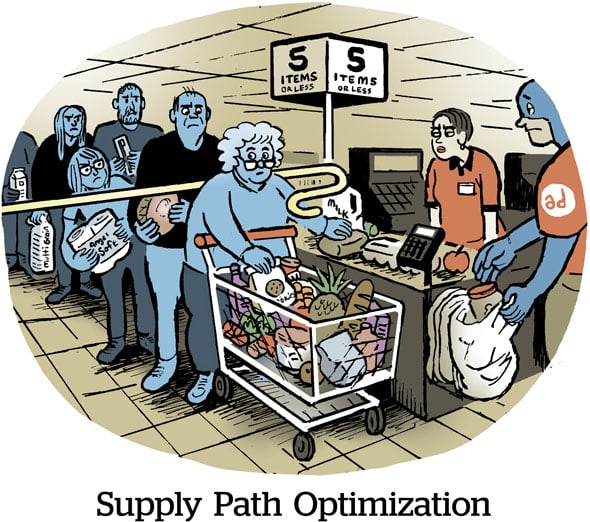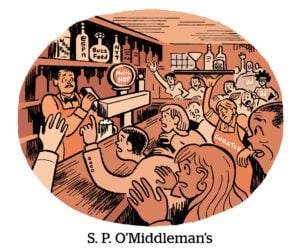It’s been nearly a year since Yahoo DSP launched Backstage, its direct-to-publisher connection.
It debuted at a time when DSPs and SSPs were launching solutions that bypass different parts of the programmatic supply chain. Yahoo and fellow DSP The Trade Desk introduced products that cut out SSPs, while SSPs PubMatic and Magnite launched solutions that circumvent DSPs for certain video-based campaigns.
All of these innovations were driven by the supply-path optimization trend, whereby advertisers work with fewer, trusted partners to avoid wasted spend, ad tech take rates and data leakage.
Since launch, 82% of advertisers that buy inventory through the Yahoo DSP have tried Backstage at least once. In Q1 alone, nearly 26,000 campaigns ran on Backstage.
The rate of adoption for Backstage suggests a healthy appetite among buyers for a more direct path to publisher inventory and is “almost double what I anticipated,” said Adam Roodman, SVP of product strategy and management at Yahoo DSP.
Why? Beyond eliminating the need for advertisers to buy Yahoo’s inventory through an SSP, Backstage also brings advertisers closer to publishers they want to work with, which is especially valuable in the highly competitive CTV market.
A buyer’s perspective
A more direct supply path with fewer ad tech intermediaries between buyer and seller means more high-quality ad inventory is available at lower CPMs, said Nidhi Gupta, senior director and global head of paid media at eBay.
EBay has served over 10 million ad impressions through Backstage so far in Q2, and CPMs on average have been 60% lower than non-Backstage CPMs, Gupta said.
The pricing is notable because Yahoo pitches Backstage as the main source for its most in-demand inventory. Competition among advertisers bidding for these coveted placements should drive prices up. But because buyers only have to pay Yahoo’s take rate when they buy through Backstage, prices end up much lower than they would normally be for an ad auction conducted through both a DSP and an SSP.
Backstage’s ad inventory also performs better than other placements, Gupta added. EBay uses Adelaide, a third-party attention measurement solution, to assess media quality and found that the inventory it purchases through Backstage averages a 4% higher attention rating than industry benchmarks, she said.
Backstage also helps eBay be more deliberate about its outreach to Gen Z and millennials through CTV platforms. Backstage has streaming partnerships with Tubi and FuboTV, both of which are popular with those demos.
And buyers can choose to purchase certain subsets of Backstage inventory, such as live sports or millennial-focused content, Gupta added.
Curating the premium internet
According to Roodman, Yahoo made it a priority to give buyers flexibility when it designed Backstage as a spiritual successor to its SSP business, which the company shut down in February 2023.
To have 82% of Yahoo buyers try Backstage “gives us the confidence to double down on this investment going forward,” said Roodman, who previously served as the head of Yahoo’s SSP.
Yahoo has learned a lot over the past year about what buyers are looking for in a direct-to-publisher connection, which will inform its future development plans.
For example, Roodman said, Yahoo realized how much advertisers are starved for metadata on the specific content they’re buying, especially for their CTV campaigns.
Yahoo is now working to provide buyers with more placement-level transparency and clarity around the composition of Backstage’s curated private marketplaces (PMPs), Roodman said. Still, some publishers – especially in the CTV space – are more comfortable with sharing placement-level data with buyers than others, he said.
Thus far, Yahoo has not shared any placement-level data with eBay, Gupta said. However, Yahoo does tell eBay which publishers were part of its Backstage campaigns.
A DSP can provide that transparency to buyers more easily than they’d get through PMPs created by an SSP, Roodman said.
SSPs “all have their different versions of a data taxonomy,” he said. “[But] when we get direct access to publisher inventory, we have one taxonomy that is consistent from publisher to publisher, which makes the data targeting that much more high fidelity.”
Going Backstage on the inventory makeup
In addition to inventory transparency, Yahoo has also spent the past year figuring out what publisher inventory is most in demand among its buyers, Roodman said.
Backstage’s current publisher mix is roughly comparable to the list of top 100 publishers The Trade Desk recently released, he said. Backstage still mostly represents the top 100 display publishers and top 40 CTV publishers in Yahoo’s DSP in terms of demand, he added.
But Yahoo has made some additions to its publisher roster over the past year, including Vevo, DIRECTV, The E.W. Scripps Company, LG Ad Solutions, Mediavine, Realtor.com, TelevisaUnivision and Warner Bros. Discovery.
Yahoo confirmed some publishers were removed as others have been added, although it didn’t name any of the pubs no longer on the roster.
Generally speaking, Backstage is prioritizing publishers that allow Yahoo direct access to their ad servers and can integrate Yahoo directly into their header-bidding wrappers, Roodman said. For that reason, Yahoo tends to avoid integrating publisher ad networks into Backstage, he added. Although there have been exceptions, such as Mediavine and Raptive, which serve as the exclusive sales partners for the publishers they represent.
Backstage also includes a handful of publishers that focus on minority and LGBTQ-targeted inventory, and Yahoo has curated more than 25 PMPs for connecting advertisers to this inventory.
And Yahoo is working with Jounce Media and Sincera to ensure Backstage doesn’t include made-for-advertising (MFA) sites.
But Yahoo is still not conducting yield optimization for Backstage publishers, Roodman said. It’s staying out of the SSP business and remaining focused on increasing its DSP’s value for buyers.
“We are leaning into finding partnerships that drive value for our customers,” Roodman said, “and this will be a continued theme into the back half of this year in areas like creative and measurement.”


















